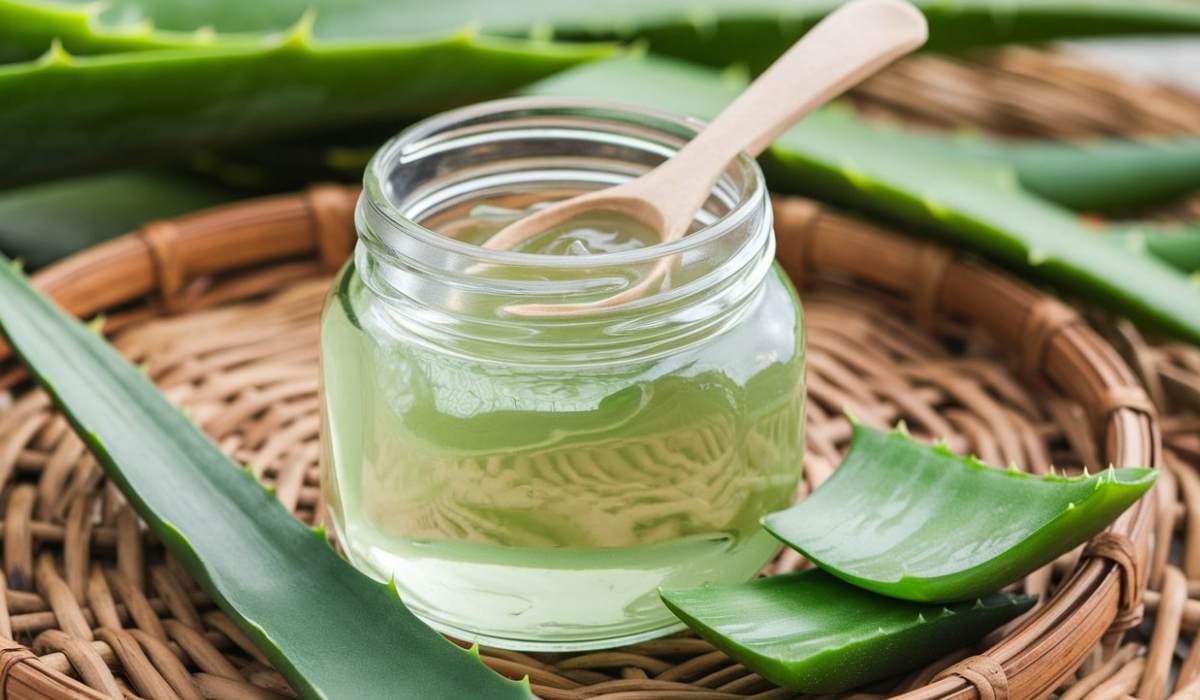The Smart Guide to Choosing the Best Aloe Vera Gel
It’s great to see so many natural aloe gel bottles in stores now.
Before, it was hard to find real natural ones. Now we’ve got quite a few more choices, thankfully.
Although it is reassuring to see more high-quality products out there, watch out. Some still mix in cheap or dubious ingredients while boasting about their “natural aloe vera” gel.
As someone who loves aloe and makes my own natural, organic skincare gels, I can tell good ingredients from questionable ones.
Let me teach you to spot the best natural aloe vera gels. That way, you can make sure to enjoy all the benefits.
Why Learning to Find Quality Aloe Gels Matters
Being able to tell a really good, natural, and pure aloe vera gel from a not-so-good one matters because you want the gel to be as nutrient-rich as possible and as legitimate as it claims on the label.
Even well-known “natural” brands sometimes add ingredients that look safe but can irritate your skin.
You’ve got to look closely to spot these sneaky additions.
Companies use dubious ingredients (from thickeners to preservatives) and count on you, the buyer, not questioning every ingredient.
My job as a health coach and organic skincare formulator is to help you identify genuine gels from duds that claim to be natural.
Aloe Vera Gel: Nature’s Soothing Superstar
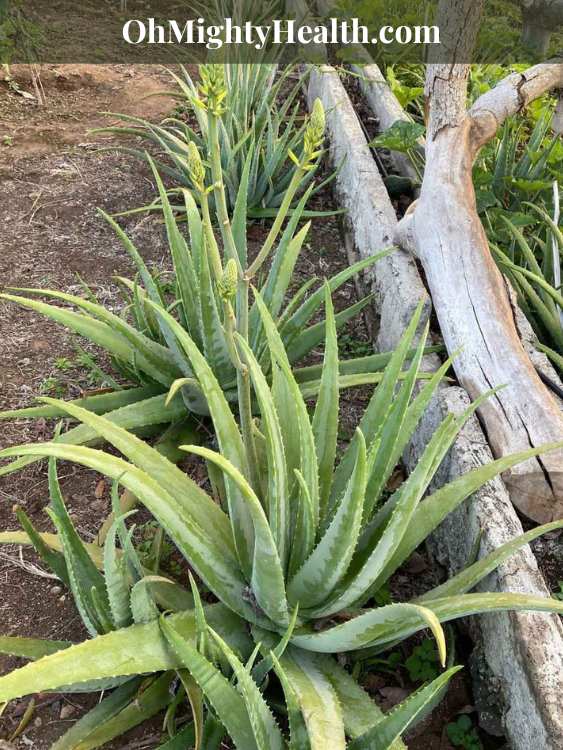
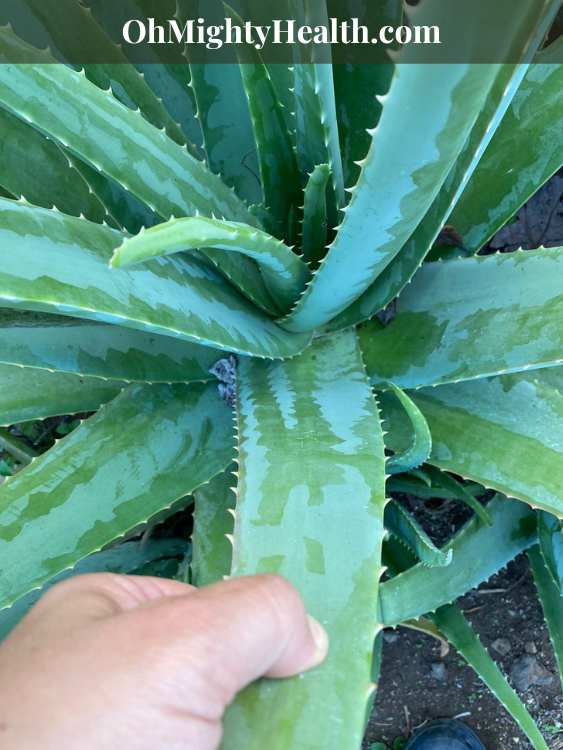
Aloe vera has centuries of use in soothing and healing skin with its over 200 active compounds. This makes it deeply nourishing.
With such impressive skin-enhancing effects, it’s crucial you learn to pick the right aloe gel.
It’s time to turn you into a smart aloe vera gel shopper!
Reading and Understanding Labels on Aloe Vera Gel Bottles
The first step is to read and understand the labels.
Ingredient lists can be intimidating with all those science-related words. Don’t worry – learning just a few basic tips will go a long way in choosing quality aloe gels.
I’ll break things down into easy tips so reading labels feels simple. Just the basics are super helpful, and I’ll guide you all the way.
Soon, you’ll shop aloe gels, feeling sure of the best picks.
Ingredients to Look For (The “Good” Ingredients)
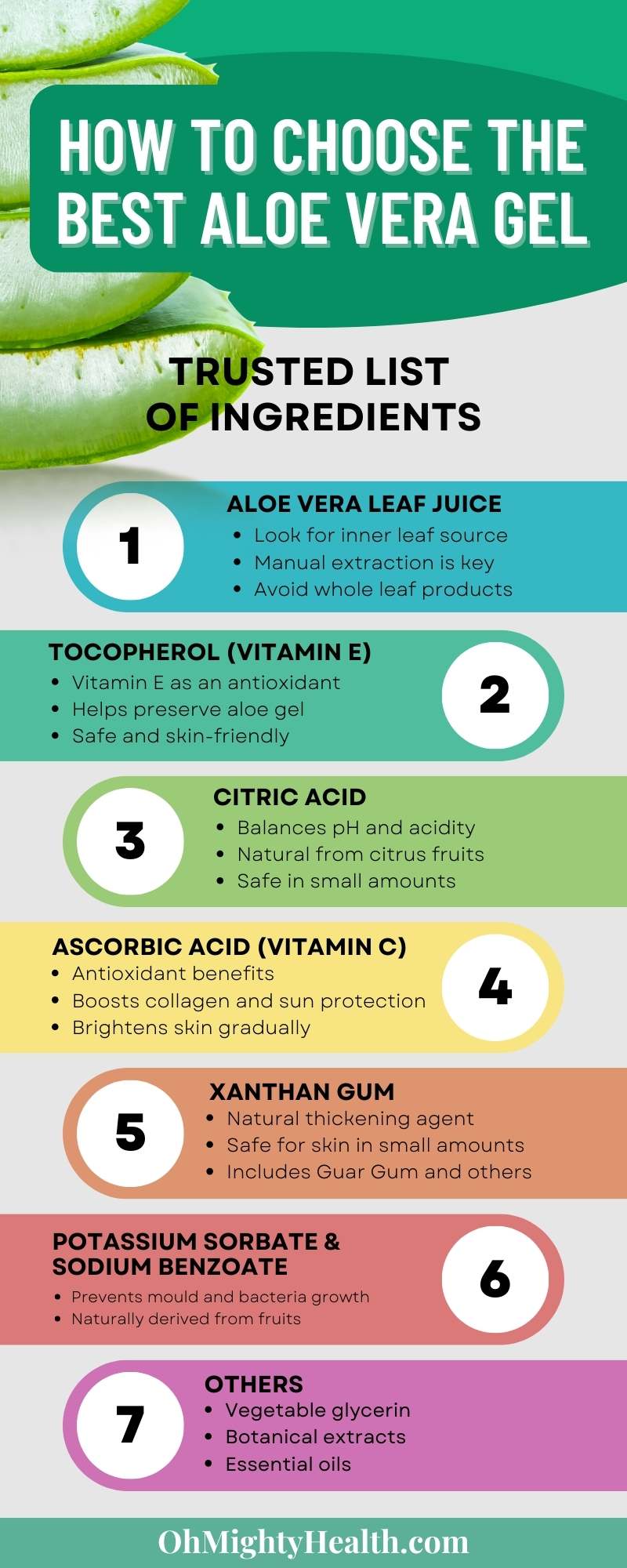
NOTE: The further down an ingredient appears on the list, the smaller its quantity in the formula.
- ✔ Aloe Barbadensis Leaf Juice: You might find “Aloe Leaf Juice”, “Aloe Vera Gel”, “Aloe Vera”, or “Aloe Juice” on labels. The important part is that it’s sourced from the inner part of the aloe vera leaf, not from powdered forms. The best quality gel comes from manually extracted fillets. This method focuses on the nutrient-rich inner gel, avoiding the outer leaf, which may contain skin-irritating aloin. Manually extracted gel is richer in beneficial aloe components like vitamins, minerals, and amino acids, making it more effective. Products using the whole leaf might not match this purity and skin benefits. Stick to gels from manually filleted leaves for the best quality.
For a better grasp of what I’ve just explained, check out this video:
- ✔ Tocopherol (Vitamin E): Vitamin E is an antioxidant that helps stop damage from things like sunlight or pollution. Having some vitamin E in aloe gel helps keep it fresher for longer. Vitamin E is natural and comes from plant oils, so it is very gentle and good for the skin. There are no big warnings here – it is safe and helpful.
- ✔ Citric Acid: Citric acid helps control products’ acidity level and pH. It comes naturally from citrus fruits and ensures your skin won’t get irritated. Nothing wrong with citric acid in small amounts.
- ✔ Ascorbic Acid (Vitamin C): Like vitamin E, vitamin C is an antioxidant in aloe vera gel formulas, enhancing the overall benefits and efficacy of the gel. Vitamin C is crucial in building healthy collagen, protecting against sun damage, and gradually brightening the skin.
- ✔ Xanthan Gum (and other gums like Guar Gum): Xanthan gum is a common ingredient used to thicken aloe vera gels, making them easier to apply without harming the skin. It is the natural thickener I use in my aloe vera gels. Xantham gum is created by fermenting sugars with bacteria and is typically added in small amounts to the final product, usually around 0.1-1%. Other similar thickening agents you might see on labels include Guar Gum, Locust Bean Gum, or Agar Agar. These gums are also safe and effective for thickening purposes, and they all get my thumbs up for use in natural aloe vera gels.
- ✔ Potassium Sorbate: Potassium sorbate stops mould, fungi, and bacteria from growing. Produced naturally from berries/fruit. No big issues as long as you’re not sensitive.
- ✔ Sodium Benzoate: Sodium Benzoate also preserves products from spoiling without being harsh. Occurs in cranberries, cinnamon, etc. Works best paired with vitamin C.
- ✔ Vegetable Glycerin: This is a good moisturiser and a humectant, which means it’s great at grabbing water and keeping it in your skin. It’s made from plant oils and is generally a good choice for most people. There are very few reasons to avoid it, making it a reliable ingredient in natural aloe vera gels.
- ✔ Rosemary Extract: Rosemary extract lends its antioxidants to protect skin from damage over time. Obviously, it’s perfectly safe as it’s straight from the herb itself.
Ingredients to Avoid (Chemical No-Nos)
Watch out for any of these words in the ingredients list:
- ❌ Artificial Colours: Synthetic colours can potentially irritate the skin, so it’s best to avoid them.
- ❌ Synthetic Fragrances: Synthetic fragrances often contain hidden allergens and irritants, so choose unscented or naturally scented options.
- ❌ Ethanol, Alcohol Denat: These alcohols can dry and irritate the skin, so choose alcohol-free options. More information here.
- ❌ Parabens (methylparaben, propylparaben): Parabens have been linked to potential health concerns, so choose paraben-free products.
- ❌ Phthalates (dibutyl phthalate, diethyl phthalate): Phthalates may adversely affect health, so opt for phthalate-free options.
- ❌ Sulfates: Sulfates can be harsh and dry on the skin, so choose sulfate-free products. They are simply controversial.
- ❌ Formaldehyde: Formaldehyde and formaldehyde-releasing preservatives can sensitise and irritate, so go for formaldehyde-free options.
- ❌ Triethanolamine (TEA): TEA can cause sensitization in some individuals, so choose TEA-free products.
- ❌ Propylene Glycol: Propylene glycol can irritate some people, so choose propylene glycol-free options.
- ❌ Diazolidinyl Urea: Diazolidinyl urea releases formaldehyde and can be sensitising, so opt for Diazolidinyl urea-free products.
- ❌ Mineral Oil: Mineral oil can potentially clog pores, so choose mineral oil-free options.
- ❌ PEG Compounds (PEG-150): PEG compounds can be potential irritants, so choose PEG-free products.
- ❌ Carbomer: Carbomer can be potentially irritating, so go for carbomer-free options.
- ❌ Synthetic Dyes (FD&C Colors): Synthetic dyes can potentially irritate the skin, so it’s best to avoid them.
- ❌ GMOs: Genetically modified organisms should be avoided if you prefer natural and organic products. More about GMO in cosmetics here.
Example of the Perfect Ingredients List
The below ingredients ensure the aloe vera gel is 100% pure inner leaf fillet gel without any synthetic additives, thickeners, colourants, fragrances, or nasty preservatives:
- Aloe Barbadensis Leaf Juice – This should be the first/main ingredient. It indicates pure inner fillet aloe vera gel.
- Tocopherol (Vitamin E) – A natural preservative and antioxidant. It is derived from vegetable oils.
- Citric Acid – A mild natural preservative and pH adjuster. Naturally, it occurs in citrus fruits.
- Ascorbic Acid (Vitamin C) – A potent antioxidant that helps stabilise the aloe gel.
- Xanthan Gum – A food-grade natural thickener and stabilizer.
- Potassium Sorbate – A gentle preservative naturally occurring in some fruits.
- Sodium Benzoate – A natural sodium salt preservative found in many foods.
The ingredients listed provide everything needed for a quality aloe gel.
With aloe vera juice as the star and majority component, the few additional natural ingredients safely maximize stability and integrity without harsh additives.
This short combination allows the aloe’s benefits to shine. Companies following this clean formula prove you don’t need more than plants to create an effective, gentle, natural gel.
When buying, keep it simple – if you recognise all components as pure substances from nature, you’ve likely found a good product!
No water, carbomer, triethanolamine, sulfates, parabens, phthalates, PEG compounds, formaldehyde releasers, GMOs, or other questionable ingredients should be present in a truly natural, high-quality aloe vera gel.
Let’s Look at Some Labels
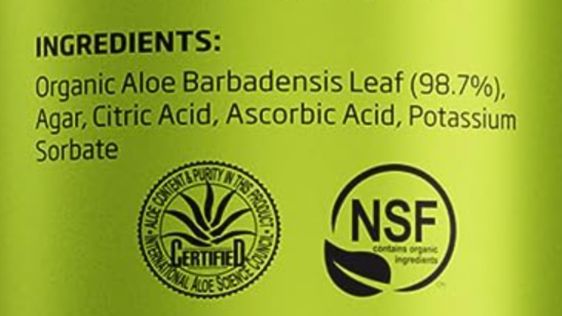
Good job on spotting a winner! This label’s star ingredient is organic aloe vera, well-loved for its skin-soothing magic. The other ingredients are straightforward helpers that keep the product safe and effective. If you thought this label looked good, you’re right on track – it’s clean, honest, and kind to your skin. Keep this up, and you’ll be a label-reading pro in no time!
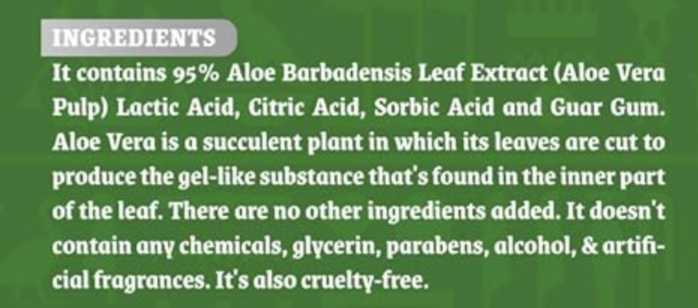
And here’s another one to applaud! If you guessed this is another good label, you’re absolutely spot on. With 95% Aloe Barbadensis Leaf Extract and a handful of simple, gentle ingredients, it’s keeping things real. No nasties like parabens or artificial fragrances here, and it’s cruelty-free too – so not only is your skin breathing a sigh of relief, but your conscience can too. If you’re nodding in approval, trust that instinct – you’re becoming a savvy label detective already! Keep it up!

Nicely done once again! This label is brimming with skin-loving ingredients, from hydrating aloe vera to calming chamomile and refreshing tea tree oil. Plus, it’s got sodium hyaluronate for that moisture boost and xanthan gum to tie it all together (I hope you Googled sodium hyaluronate. We want you to learn to do your research!). There are no hidden surprises here – just pure, soothing goodness. If you’re giving this label a thumbs-up, you’re definitely getting the hang of this. Your skincare label-reading skills are top-notch! Keep going – your perfect aloe vera gel is just around the corner.

You’re on a roll! This ingredient list is almost as pure as it gets, boasting 99% certified organic aloe vera. It’s supported by xanthan for texture, citric acid for pH balance, vitamin C for skin health, and potassium sorbate to keep it fresh. If this label made you smile, you’re right to feel proud. It’s a clean, straightforward choice for anyone seeking a gentle and effective skincare product. Your label-deciphering eye is getting sharper with each one! Keep up the great work!
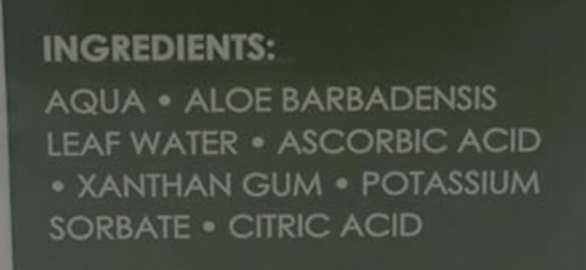
This label leads with ‘Aqua,’ so it’s primarily water-based, which can be a bit dilute if you’re after the full benefits of aloe vera. It does include Aloe Barbadensis Leaf Water and some beneficial additives like Vitamin C and natural preservatives, but if you’re in the market for something with a higher concentration of aloe, you might want to keep looking. This one’s a decent pick for light hydration but may not be the powerhouse you’re seeking.

When seeing an aloe gel with just leaf juice and glycerin it raises questions. Skincare does require some preservatives for safety and stability over time. Without them, microbes can grow quickly. This barebones label implies natural purity but seems dubious – are preservatives used but not disclosed? Does it need refrigeration to last barely? Transparency with all ingredients is key. An aloe gel should list everything included so you know exactly what you’re using. If it seems obscure, it’s wise to seek a clearly labelled alternative you feel fully comfortable with cautiously.

This label is straight-up and simple, boasting a high percentage of certified organic aloe vera, which is a thumbs-up for purity and quality. The xanthan gum and citric acid are there to keep the gel in good shape and long-lasting. It’s a clean and transparent list, ticking the boxes for those who like their skincare green and clean. If you’re giving this one the nod, you’re all about that natural goodness. Keep on trusting those instincts!

This one is a no-no for me. It’s got a bit more going on. The dubious extras like alcohol denat can be drying for some, and a few more scientific-sounding bits like carbomer and triethanolamine for texture and stability are not what we want. And yes, there are colours and a fragrance in the mix, too. Remember what we said about these above. Keep that label-savvy eye sharp!

This label definitely catches the eye with its high percentage of certified organic aloe vera, which is great for the skin. Glycerin and sodium hyaluronate are also included for their hydrating properties. However, it’s worth noting the presence of carbomer and triethanolamine, which are not natural ingredients and have raised some concerns among consumers and organizations like the EWG. If you’re someone who prioritizes an all-natural or organic skincare routine, this might give you pause. It’s always important to consider what you’re comfortable with when choosing your products. Keep doing your homework on those labels!
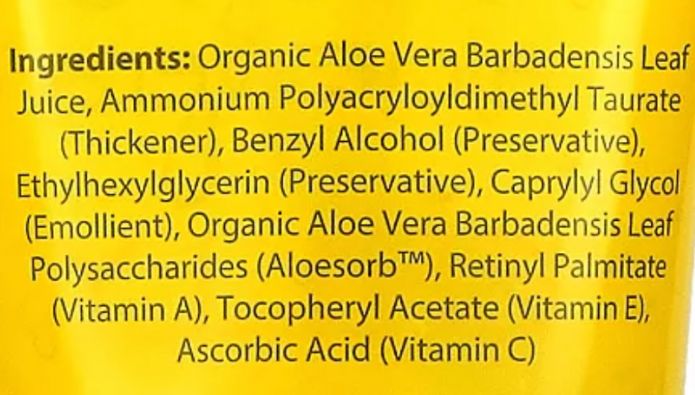
The label leads with organic aloe juice, which is excellent. However, concerning extras follow like ammonium polyacryloyldimethyl taurate, a synthetic thickening polymer. Then, preservatives benzyl alcohol and ethylhexylglycerin – decent but still synthetic versus gentle, food-sourced alternatives like potassium sorbate. The vitamins and caprylyl glycol seem reasonable. But with leading funky synthetics, I wouldn’t call this fully natural despite the highlighted aloe. Cleaner ingredient list options likely exist without polymers or chemical preservatives. One red flag additive can disrupt an otherwise good formula.
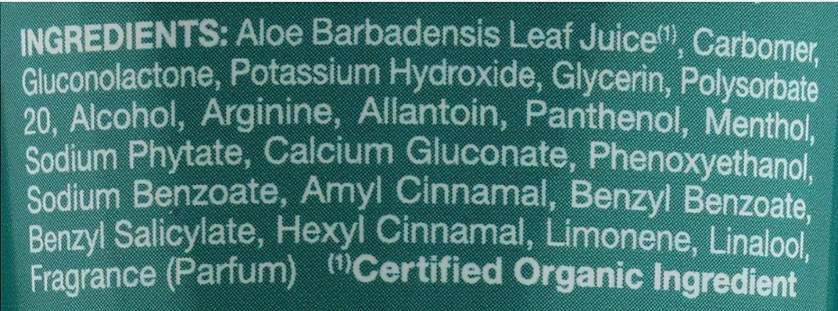
Aloe Barbadensis Leaf Juice leads – great. However, questionable components follow, like carbomer and polysorbate 20, to thicken and stabilise. Some alcohol, too. Glycerin offers moisture, albeit synthetic. Then, the preservative combo phenoxyethanol and sodium benzoate with odd fragrance elements – limonene, linalool. It could irritate sensitive skin. Rather blended bag of tricks here, not aligned with natural preference. Despite the headliner aloe, transparency is missing on some sneaky synthesisers. One iffy additive throws off an otherwise potential contender. Opting out might be wise.
I hope this guide has helped you find the right balance in your skincare labels. It’s all about combining necessary ingredients that keep products safe and stable, with the aim of staying as natural as possible. Remember, some additives are there for a reason, but they can still be gentle on your skin.
Other Factors to Consider
Now that we’ve examined various labels together, let’s focus on the key aspects to consider for a truly pure aloe vera gel:
1. Hunt for purity
- Look for aloe vera gel that has been made with the inner leaf juice or inner leaf gel. I avoid products that have used the entire aloe vera leaf.
- Avoid products with added colours, fragrances, or thickeners like carbomer (xantham gum and other gums are ok).
- Check the label for the percentage of aloe vera. Aim for 90% or more aloe vera juice or gel from the inner leaf.
- Stay away from gels with unnecessary additives or fillers. You can recognise them by their long list of ingredients that are hard to pronounce.
- ALWAYS AIM FOR SIMPLICITY.
NOTE: In some aloe vera gels, they use the entire leaf. This means they grind up the leaf, both the inner gel and the outer skin. I avoid these products as the outer leaf can contain aloin, a compound that can be irritating and less soothing for the skin, especially for those with sensitive skin types.
2. Check the processing method when possible
Cold-pressed aloe vera gels tend to preserve more nutrients, so keep an eye out for those. Gels that have been overly processed may not have the same benefits.
TIP: Check the label for “cold-pressed” or “cold-processed” – it’s usually right there if they do it. Not seeing it? No worries, pop over to the brand’s website or shoot them a quick message. The best brands are usually super open about how they make their products, so you’ll know you’re getting something great.
3. Organic or Bust?
Do you prefer organic or non-organic aloe vera gel? Also, consider where the aloe vera is sourced from.
PRO TIP: When scouting for organic aloe vera gel, keep an eye out for official organic certification labels. In the U.S., this is typically the USDA Organic seal. Across Europe, the EU Organic logo is your go-to indicator. Take a moment to check out the ingredient list; if it’s genuinely organic, you’ll find ‘organic’ listed right before ‘aloe vera’.
4. Ingredients: Acceptable vs Alarming
When scrutinising the ingredient list, be on the lookout for preservatives or additives that you prefer not to use. Refer to the guidelines I provided earlier for ingredients that are good to have and those you might want to steer clear of.
EXTRA TIP: Familiarise yourself with common preservatives that can be gentle and safe, like ascorbic acid or citric acid. These can help keep your aloe vera gel effective without the harsh side effects that other preservatives might have.
5. Concentration/Strength
Gels with a higher concentration of aloe vera generally have more nutrients. Diluted gels may not have the same therapeutic value. Consider the concentration you need based on your specific requirements.
BONUS TIP: If you’re using aloe vera gel for a specific skin concern, do a little research or consult a dermatologist to understand the optimal concentration. Sometimes, even a less concentrated gel, when formulated with complementary ingredients, can be beneficial for everyday use.
6. Freshness: Check Those Dates
Freshness in aloe vera gel is key. Look for the expiration date. The fresher the gel, the more potent its nutrients and benefits will be for your skin.
EXTRA TIP: Don’t hesitate to ask the seller about the product’s freshness. Aloe vera gels lose their potency over time, so using a fresh batch ensures you’re getting the best of its soothing and healing properties.
7. Certifications
Certifications can be a reliable indicator of quality and ethical production. Keep an eye out for labels like USDA Certified Organic, COSMOS, Ecocert Certified, NSF Certified for Organic Standards, Leaping Bunny Certified, or Fair Trade Certified. These certifications often mean the product meets higher standards for organic ingredients, ethical sourcing, and cruelty-free practices.
EXTRA TIP: While certifications are a good sign, they’re not the only indicator of a product’s quality. Sometimes, smaller brands might not have the resources for these certifications but still follow ethical and organic practices. A little research into the brand’s values and production methods can give you additional assurance.
8. Packaging
The packaging of aloe vera gel plays a crucial role in preserving its quality. Look for dark glass or opaque bottles, as they help prevent oxidation and maintain the gel’s effectiveness. BPA-free plastic containers are also a good option. The type of packaging can significantly affect the stability and shelf-life of the gel.
EXTRA TIP: If you’re eco-conscious, check the packaging’s recyclability too. Sustainable packaging options not only protect your aloe vera gel but also help reduce environmental impact. Plus, good packaging design can make the product easier and more enjoyable to use.
9. Pricing Tips – Value vs Ripoff
Be aware of the price range and quality of aloe vera gels. Suspiciously cheap gels may not be the best quality. High-quality products often come with a higher price tag. Look for reputable brands and read reviews to help you make a decision.
EXTRA TIP: Sometimes, buying in larger quantities can offer better value, but make sure you can use it up before it expires. Also, watch out for sales or special offers from trusted brands to get quality products at a more affordable price.
10. Ethical Sourcing
Consider the eco-friendliness of the packaging and the brand’s practices. Look for ethical production and cruelty-free practices in the sourcing of aloe vera gel.
PRO INSIGHT: Investigate the brand’s ethos and transparency in its practices. This can often reveal more about the product’s quality and the company’s integrity, guiding you to make a more informed and ethical choice.
Keeping Your Aloe Vera Fresh
To keep your aloe vera gel fresh:
- Store it in a cool, dark place. Heat and sunlight can reduce its effectiveness.
- Refrigerate after opening. This helps extend its shelf life and prevents spoilage. Make sure the container is tightly sealed.
- Use within one year of harvest for best quality. Over time, the gel loses potency. Always check the expiration date.
Signs of Spoilage
- Colour Changes: If the gel turns darker or discoloured, it could be spoiled.
- Texture and Smell: Clumpy, slimy texture or bad odour means it’s time to discard.
- Mould or Bacteria: Look for fuzzy patches, specks of mould, or signs of bacteria. These indicate it’s unsafe to use.
- Separation or Thinning: Significant separation or watery consistency suggests it’s gone bad.
- Safety Reminder: Using spoiled aloe
Safety Tips
- Patch Testing: Apply a small amount of aloe vera gel to a small skin area. Wait 24 hours before regular use for redness, itching, or swelling reactions.
- When to Avoid: Don’t use aloe or its ingredients if allergic. Avoid open wounds, deep cuts, or serious burns – see a doctor instead.
- Interactions with Medications/Products: Check with a healthcare provider about potential interactions with medications or other topical treatments before using aloe vera gel.
NOTE: I may earn a commission from the affiliate links below.
My Recommended List of Trusted Brands
I’ve carefully selected these brands for their outstanding quality and natural ingredients:
These are my top picks, offering pure, high-quality aloe vera gel. They balance naturalness and commercial standards excellently, making them reliable choices for products that are safe, effective, and close to nature.
Additional Resources
- aloevera.com — The official website with comprehensive information about the benefits, products, and usage of aloe vera.
- PubMed Central — Research articles on the uses and benefits of aloe vera gel.
- Environmental Working Group (EWG) Skin Deep Database — Check the safety and ingredient ratings of personal care products, including aloe vera gel.
- World Health Organization (WHO) – Medicinal Plants and Traditional Medicine — Information on traditional uses and safety of medicinal plants, including aloe vera.
Conclusion
We’ve covered a lot of ground on picking great aloe gels. From suspicious thickeners to pure inner leaf juice, ingredient lists reveal true quality.
I aimed to turn tricky labels into signs of care and integrity. Showing how transparency means everything in a great aloe gel, while perfection comes from plants, not chemicals.
Some additives serve a purpose, but simple is best. Now, you can spot hidden nasties and true plant goodness.
Trust yourself to find gels using thoughtful choices for your skin and hair goals. Whether seeking to soothe irritation, nourish dry hair, or refresh skin, you’ve got this!
Here’s to the power of plants, simpler ingredients, and your new aloe shopping skills!
This article was written by certified Health Coach Patri Hernandez and fact-checked by M. Candelaria Coto González, B.Sc., on 28 November 2023. Articles are updated when new information is available. ☑ Evidence-based.
Our Commitment to Accuracy
Upholding trust through rigorous content review.
Correction Log
None to date.
Fact-Checked & Verified
At ohmightyhealth.com, we are committed to providing accurate and trustworthy information. Each article undergoes a rigorous review process to ensure its content reflects the best available information at the time of publication.
Article Review Details
- Date of Review: 28 October 2023
- Reviewed By: María Candelaria Coto González, B.Sc.
- Credentials: Bachelor’s in Chemistry
- Experience: Chemistry teacher for the generic Secondary Education Institutes of the Canary Islands Government programme for 33 years. 1, 2
Disclaimer
Our editorial team reviewed this article for accuracy and thoroughness. However, it’s important to understand that the content reflects the best information available at the time of publication and should not be used as a substitute for professional advice or judgment.
Cross-Referencing
Our content is cross-referenced with multiple sources to ensure accuracy and reliability.
Feedback & Corrections
We value our readers’ insights and encourage you to leave comments or feedback. If you notice any inaccuracies or have additional insights to offer, please let us know. Your feedback helps us uphold the highest standards of content quality.
Learn More About Our Editorial Standards
For a deeper understanding of our commitment to editorial integrity, you can visit our Editorial Process and Editorial Principles.
Resources
- Bozzi A, Perrin C, Austin S, Arce Vera F. Quality and authenticity of commercial aloe vera gel powders. Food Chemistry [Internet]. 2007 [cited 2023 Nov 27]; 103(1):22–30. Available from: https://www.sciencedirect.com/science/article/pii/S0308814606006066.
- Aloe Vera Gel Research Review [Internet]. [cited 2023 Nov 27]. Available from: https://www.naturalmedicinejournal.com/journal/aloe-vera-gel-research-review.
- Hekmatpou D, Mehrabi F, Rahzani K, Aminiyan A. The Effect of Aloe Vera Clinical Trials on Prevention and Healing of Skin Wound: A Systematic Review. Iran J Med Sci [Internet]. 2019 [cited 2023 Nov 27]; 44(1):1–9. Available from: https://www.ncbi.nlm.nih.gov/pmc/articles/PMC6330525/.
- Surjushe A, Vasani R, Saple DG. ALOE VERA: A SHORT REVIEW. Indian J Dermatol [Internet]. 2008 [cited 2023 Nov 27]; 53(4):163–6. Available from: https://www.ncbi.nlm.nih.gov/pmc/articles/PMC2763764/.
- Sabbaghzadegan S, Soltani MH, Kamalinejad M, Bahrami M, Kabir A, Dadmehr M. The effect of a standardized capsule of Aloe vera gel on the quality of life in patients with systolic heart failure: A randomized double‐blind placebo‐controlled clinical trial. Phytotherapy Research [Internet]. 2023 [cited 2023 Nov 27]; 37(7):2800–10. Available from: https://onlinelibrary.wiley.com/doi/10.1002/ptr.7775.
- Sandoval AP, Rodríguez NSS, Calzada RT, Zegbe-Dominguez JA, Minjares-Fuentes R, Samaniego-Gaxiola JA. Leaf production and gel quality of Aloe vera (L.) Burm. F. under irrigation regimens in northern Mexico. Journal of the Professional Association for Cactus Development [Internet]. 2022 [cited 2023 Nov 27]; 24:139–48. Available from: https://www.jpacd.org/jpacd/article/view/497.

